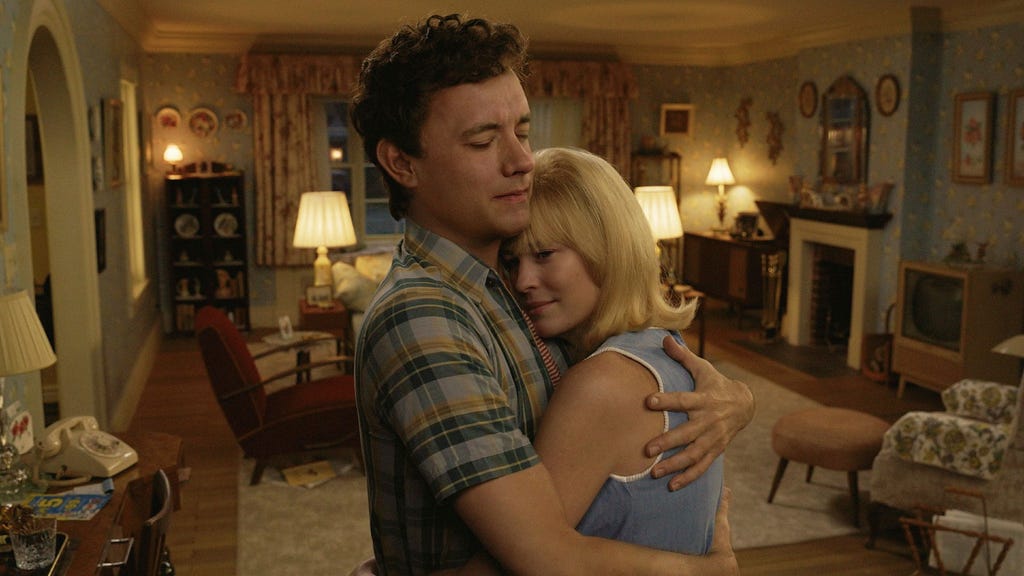Robert Zemeckis and Tom Hanks, the iconic duo behind ”Forrest Gump,” reunite in ”Here,” a film adaptation of Richard McGuire’s six-page graphic novel. This ambitious project undertakes a cinematic experiment, confining the narrative to a single, unchanging location – a corner of a room – while time unfolds across centuries, from prehistory to a distant future. The film’s premise hinges on exploring the myriad lives and events that transpire within this confined space, effectively turning this unassuming corner into a microcosm of human existence. This static setting becomes a stage for a sweeping historical drama, witnessing the evolution of life, love, loss, and the relentless march of time.
The film’s ingenuity lies in its technical execution. Rather than employing traditional narrative techniques, Zemeckis leverages advanced visual effects to depict the passage of time within the single, fixed frame. The same actors, including Hanks and Robin Wright, portray characters across different eras, seamlessly transitioning between ages thanks to de-aging and aging technology. The room itself transforms through digital wizardry, reflecting the architectural and interior design styles of each period, from rudimentary prehistoric dwellings to futuristic, technologically advanced living spaces. This consistent backdrop serves as a fixed point of reference against which the dynamism of human history unfolds, emphasizing the ephemeral nature of individual lives against the backdrop of enduring space.
This unique approach to storytelling presents both exciting possibilities and inherent challenges. By confining the action to a single location, the film forces a deep introspection into the human condition, exploring the cyclical nature of history and the enduring themes of life and death within a limited physical space. The unchanging nature of the location accentuates the transience of human existence, highlighting how generations come and go, leaving their indelible mark, however faint, on this shared space. The narrative, therefore, becomes less about physical journeys and more about the internal journeys of the characters who inhabit this space, their hopes, dreams, and struggles playing out against the backdrop of the larger historical narrative.
However, maintaining audience engagement within such a restrictive setting might prove demanding. The lack of dynamic camera movement and traditional plot progression could lead to a sense of monotony if not handled with meticulous precision. The success of ”Here” hinges on its ability to create compelling character arcs and emotional resonance despite the limitations of its premise. The film’s reliance on visual effects, while innovative, runs the risk of overshadowing the human drama at the heart of the story. The challenge lies in finding a delicate balance between showcasing technological prowess and delivering a genuinely moving and engaging narrative.
The film’s static nature also poses challenges for traditional storytelling. Without the usual cinematic tools of shifting perspectives and changing locations, the narrative must rely heavily on dialogue, character interactions, and the visual transformation of the space to convey the passage of time and the unfolding of events. This reliance on subtle cues and nuanced performances demands a high degree of sophistication from both the filmmakers and the audience. The film invites viewers to actively participate in the storytelling process, piecing together the narrative fragments and inferring meaning from the visual and auditory clues presented within the frame.
Ultimately, ”Here” presents a daring cinematic experiment, pushing the boundaries of traditional storytelling. Its success will depend on whether it can translate the static nature of its setting into a dynamic and emotionally resonant experience for the viewer. The film’s premise, while inherently limiting, offers the potential for a profound exploration of the human condition, examining the ephemeral nature of individual lives against the backdrop of enduring space and the relentless march of time. Whether this ambitious project succeeds in its unique approach remains to be seen, but it undoubtedly marks a significant departure from conventional filmmaking and a bold exploration of cinematic possibilities.














